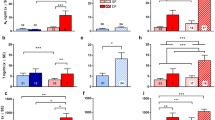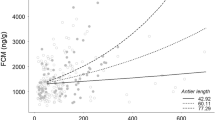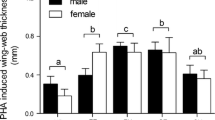Abstract
The immunocompetence handicap hypothesis (ICHH) suggests that dominance signals are costly because their development is controlled by testosterone, which is immunosuppressive. Signal control therefore links an increased disease risk with a high quality signal. The chest bib of the house sparrow, Passer domesticus, is a signal known to be related to dominance and under control of testosterone levels. We experimentally manipulated testosterone in male sparrows during the breeding season and again independently during the post-breeding period to test whether variation in levels of testosterone could cause variation in levels of immunocompetence. There was no effect of testosterone manipulation on the cell-mediated response of birds to phytohaemagglutinin injection, nor did testosterone levels appear to affect either white blood cell ratios or red blood cell counts. In contrast, both breeding season and post-breeding season testosterone levels had significant effects upon the humoral response of the birds to sheep red blood cell injections. However, whilst testosterone during the breeding season appeared to act immunosuppressively, the role of post-breeding levels is less clear. In concordance with a previous study, there was an indication that corticosterone is involved in mediating the immunosuppressive effects of testosterone. The strength of the secondary humoral response and the cell-mediated response were negatively related suggesting the possibility of a trade-off between the different arms of the immune system. These results provide some support for the ICHH as a mechanism promoting the evolution of costly badges of status, although the results question whether the immunosuppressive cost can be mediated by testosterone at the time of badge development.





Similar content being viewed by others
References
Andersson M (1994) Sexual selection. Princeton University Press, Princeton, N.J.
Barnard CJ, Behnke JM, Sewell J (1996) Social status and resistance to disease in house mice (Mus musculus): Status-related modulation of hormonal responses in relation to immunity costs in different social and physical environments. Ethology 102:63–84
Birkhead TR, Fletcher F, Pellatt EJ (1998) Sexual selection in the zebra finch Taeniopygia guttata: condition, sex traits and immune capacity. Behav Ecol Sociobiol 44:179–191
Braude S, Tang-Martinez Z, Taylor GT (1999) Stress, testosterone and the immunoredistribution hypothesis. Behav Ecol 10:345–350
Buchanan KL (2000) Stress and the evolution of condition-dependent signals. Trends Ecol Evol 15:156–160
Buchanan KL, Evans MR, Goldsmith AR, Bryant DM, Rowe LV (2001) Testosterone influences basal metabolic rate in male house sparrows: a new cost of dominance signalling? Proc R Soc Lond B 268:1337–1344
Casto JM, Nolan V, Ketterson ED (2001) Steroid hormones and immune function: Experimental studies in wild and captive dark-eyed juncos (Junco hyemalis). Am Nat 157:408–420
Cordero P, Wetton J, Parkin D (1999) Extra-pair paternity and male badge size in the House Sparrow. J Avian Biol 30:97–102
Deerenberg C, Apanius V, Daan S, Bos N. (1997) Reproductive effort decreases antibody responsiveness. Proc R Soc Lond B 264:1021–1029
Deviche P, Breuner C, Orchinik M (2001) Testosterone, corticosterone, and photoperiod interact to regulate plasma levels of binding globulin and free steroid hormone in Dark-eyed Juncos, Junco hyemalis. Gen Comp Endocrinol 122:67–77
Duckworth RA, Mendonca MT, Hill GE (2001) A condition dependent link between testosterone and disease resistance in the house finch. Proc R Soc Lond B 268:2467–2472
Duffy DL, Bentley GE, Drazen DL, Ball GF (2000) Effects of testosterone on cell-mediated and humoral immunity in non-breeding adult European starlings. Behav Ecol 11:654–662
Evans MR, Goldsmith AR, Norris SRA (2000) The effects of testosterone on antibody production and plumage coloration in male house sparrows (Passer domesticus). Behav Ecol Sociobiol 47:156–163
Folstad I, Karter AJ (1992) Parasites, bright males and the immunocompetence handicap. Am Nat 139:603–622
Gonzalez G, Sorci G, Møller AP, Ninni P, Haussy C, de Lope F (1999a) Immunocompetence and condition-dependent sexual advertisement in male house sparrows (Passer domesticus). J Anim Ecol 68:1225–1234
Gonzalez G, Sorci G, de Lope F (1999b) Seasonal variation in the relationship between cellular immune response and badge size in male house sparrows (Passer domesticus). Behav Ecol Sociobiol 46:117–122
Gonzalez G, Sorci G, Smith LC, de Lope F (2001) Testosterone and sexual signalling in male house sparrows (Passer domesticus). Behav Ecol Sociobiol 50:557–562
Griffith SC, Owens IPF, Burke T (1999) Female choice and annual reproductive success favour less-ornamented male house sparrows. Proc R Soc Lond B 266:765–770
Hasselquist D, Marsh JA, Sherman PW, Wingfield JC (1999) Is avian immunocompetence suppressed by testosterone? Behav Ecol Sociobiol 45:167–175
Hegner RE, Wingfield JC (1986) Behavioural and endocrine correlates of multiple brooding in the semicolonial house sparrow Passer domesticus. I. Males. Horm Behav 20:294–312
Hillgarth N, Wingfield JC (1997). Parasite-mediated sexual selection: endocrine aspects. In: Clayton DH, Moore J (eds) Host-parasite evolution: general principles and avian models. Oxford University Press, Oxford
Johnstone RA, Norris KJ (1993) Badges of status and the costs of aggression. Behav Ecol Sociobiol 32:127–134
Ketterson ED, Nolan V, Wolf JL, Zeigenfus C, Dufty AM, Ball GF, Johnsen TS (1991) Testosterone and avian life histories: the effects of experimentally elevated testosterone on corticosterone and body mass in dark-eyed juncos. Horm Behav 25:489–503
Kimball R (1996) Female choice for morphological traits in house sparrows Passer domesticus. Ethology, 102:639–648
Lessells CM, Boag PT (1987) Unrepeatable repeatabilities: a common mistake. Auk 104:116–121
Liker A, Barta Z (2001) Male badge size predicts dominance against females in House Sparrows. Condor 103:151–157
Lindstrom KM, Krakower D, Lundstrom JO, Silverin B (2001) The effects of testosterone on viral infection in greenfinches (Carduelis chloris): an experimental test of the immuncompetence-handicap hypothesis. Proc R Soc Lond B 268:207–211
Lochmiller RL, Vestey MR, Boren JC (1993) Relationship between protein nutritional status and immunocompetence in northern bobwhite chicks. Auk 110:503–510
Maxwell MH (1993) Avian blood leucocyte responses to stress. World's Poult Sci 49:34–43
McGraw KJ, Dale J, MacKillop EA (2003) Social environment during molt and the expression of melain-based plumage pigmentation in male house sparrows (Passer domesticus). Behav Ecol Sociobiol 53:116–122
Møller AP (1987a) Variation in badge size in male house sparrows Passer domesticus: evidence for status signalling. Anim Behav 35:1637–1644
Møller AP (1987b) Social control of deception among status signalling house sparrows Passer domesticus. Behav Ecol Sociobiol 20:307–311
Møller AP (1988) Badge size in the house sparrow Passer domesticus: effects of intra- and intersexual selection. Behav Ecol Sociobiol 22:373–378
Møller AP (1990) Sexual behaviour is related to badge size in the house sparrow Passer domesticus. Behav Ecol Sociobiol 27:23–29
Møller AP (1995) Hormones, handicaps and bright birds. Trends Ecol Evol 10:121
Møller AP, Kimball RT, Erritzoe J (1996) Sexual ornamentation, condition and immune defence in the house sparrow Passer domesticus. Behav Ecol Sociobiol 39:317–322
Moreno-Rueda G, Soler M (2002) Breeding in captivity of House Sparrow, Passer domesticus. Ardeola 49 11–17
Nava MP, Veiga JP, Puerta M (2001) White blood cell counts in house sparrows (Passer domesticus) before and after molt and after testosterone treatment. Can J Zool 79:145–148
Nolan PM, Hill GE, Stoehr AM (1998) Sex, size and plumage redness predict house finch survival in an epidemic. Proc R Soc Lond B 265:961–965
Norris K, Evans MR (2000) Ecological immunology:life history trade-offs and immune defense in birds. Behav Ecol 11:19–26
Parkinson T, Follett B (1995) Thyroidectomy abolishes seasonal testicular cycles of Soay rams. Proc R Soc Lond B 259:1–6
Peters A (2000) Testosterone treatment is immunosuppressive in superb fairy-wrens, yet free-living males with high testosterone are more immunocompetent. Proc R Soc Lond B 267:883–889
Poiani A, Goldsmith AR, Evans MR (2000) Ectoparasites of house sparrows (Passer domesticus): an experimental test of the immunocompetence handicap hypothesis and a new model. Behav Ecol Sociobiol 47 230–242
Råberg L, Grahn M, Hasselquist D, Svensson E (1998) On the adaptive significance of stress-induced immunsuppression. Proc R Soc Lond B 265:1637–1641
Rohwer S (1975) The social significance of avian plumage variation. Evolution 29:593–610
Rohwer S, Rohwer FC (1978) Status signaling in Harris' sparrows experimental deceptions achieved. Anim Behav 26:1012–1022
Ros AFH, Groothuis TGG, Apanius V (1997) The relation among gonadal steroids immunocompetence, body mass and behaviour in young black-headed gulls (Larus ridibundus). Am Nat 150:201–219
Schoech SJ, Ketterson ED, Nolan V (1999) Exogenous testosterone and the adrenocortical response in Dark- eyed Juncos. Auk 116:64–72
Summers-Smith, J (1988) The sparrows. Poyser, Calton, UK
Veiga JP (1993) Badge size, phenotypic quality and reproductive success in the house sparrow: A study on honest advertisement. Evolution 47:1161–1170
Verhulst S, Dieleman SJ, Parmentier HK (1999) A trade-off between immunocompetence and sexual ornamentation in domestic fowl. Proc Natl Acad Sci USA 96:4478–4481
Weiner E, Bandieri A (1974) Differences in antigen handling by peritoneal macrophages from the Biozzi high and low responder lines of mice. Eur J Immunol 4:457–463
Westneat D, Birkhead T (1998) Alternative hypotheses linking the immune system and mate choice for good genes. Proc R Soc Lond B 265:1065–1073
Westneat DF, Hasselquist D, Wingfield JC (2003) Tests of association between the humoral immune response of red-winged blackbirds (Agelaius phoeniceus) and male plumage, testosterone or reproductive success. Behav Ecol Sociobiol (in press). DOI 10.1007/s0026500205779
Wingfield J (1994). Modulation of the adrenocortical response to stress in birds. In: Davey K, Peter R, Tobey Y (eds) Perspectives in comparative endocrinology . National Research Council of Canada, Ottawa, pp 520–528
Wingfield JC, Hegner RE, Dufty AM Jnr, Ball GF (1990) The 'challenge hypothesis' — theoretical implications for patterns of testosterone secretion, mating systems and breeding strategies. Am Nat 136:829–846
Wingfield J, Vleck C, Moore M (1992) Seasonal changes of the adrenocortical response to stress in birds of the Sonoran Desert. J Exp Zool 264:419–428
Zar JH (1984) Biostatistical analysis. Prentice Hall, Englewood Cliffs, N.J.
Zuk M, Johnsen TS (1998) Seasonal changes in the relationship between ornamentation and immune response in red jungle fowl. Proc R Soc Lond B 265:1631–1635
Acknowledgements
We thank Alasdair Sherman for caring for the birds, Kirsty Park and Louise Rowe for help in the field and the laboratory and local landowners for access for mistnetting. We also thank two anonymous referees for constructive comments on an earlier draft of this manuscript. K.L.B. was supported by the Natural Environmental Research Council grant GR3/11426. All experiments were conducted under Home Office Licence (PPL 60/2256) and comply with U.K. legal requirements.
Author information
Authors and Affiliations
Corresponding author
Additional information
Communicated by W.A.Searcy
Rights and permissions
About this article
Cite this article
Buchanan, K.L., Evans, M.R. & Goldsmith, A.R. Testosterone, dominance signalling and immunosuppression in the house sparrow, Passer domesticus . Behav Ecol Sociobiol 55, 50–59 (2003). https://doi.org/10.1007/s00265-003-0682-4
Received:
Revised:
Accepted:
Published:
Issue Date:
DOI: https://doi.org/10.1007/s00265-003-0682-4




